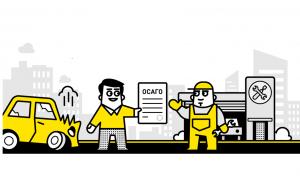Repair under compulsory motor insurance: terms, payments and pitfalls. Insured event under compulsory motor insurance Can I be sent for repairs under compulsory motor insurance?
As you know, in 2017, MTPL introduced a priority for compensation in kind (hereinafter referred to as repairs in the text) over cash payments. A number of questions arise in connection with the innovation.
What is the essence of the priority of repairs under compulsory motor liability insurance over payment?
In simple words, the priority is that instead of a cash payment, you receive a referral for repairs, which are paid for by the insurance company. At the same time, it is now impossible to choose money instead of repairs as it was before, with the exception of a small list of cases.
Let's take a look at the various issues.
1.When can you choose between money or repairs according to the old rules?
To determine whether you can get money under the old rules, you need to look at the policy of the person at fault for the accident.
The priority of repairs over payment was introduced by the Federal Law of March 28, 2017. No. 49-FZ. It came into force on April 28, 2017. This means that if the person at fault for the accident was issued a policy before this date, then the old rules apply to you, when the victim had a choice: money or repairs.
What makes up a simple calculation. The last day when an accident can occur, and you will have the right to choose if you have an old policy, is April 27, 2018.
2.Which service stations are sent to, and can a citizen choose a service station at his own discretion?
The insurance company issues a referral to the service station with which it has an agreement. The list of service stations with which the insurer has such agreements must be indicated on its website.
A citizen can carry out repairs at any other service station only if there is an appropriate agreement with the insurance company. In other words: the choice is only within the limits provided by the insurer.

3. How is the repair carried out? Does wear and tear count? Do I need to pay extra for the service station?
The law obliges the use of new parts when carrying out repairs and prohibits the installation of used ones on a car. Therefore, wear and tear is not taken into account. By the way, they can supply new non-original (Chinese) spare parts.
Additional payment for repairs is provided only if the culprit has an old policy and you chose repairs instead of money (see answer to question 1).
4. Is the warranty void when repairs are carried out under MTPL?
A mandatory requirement for a service station with which the insurer has an agreement is that it has its own agreement with the manufacturer or distributor of cars of the corresponding brand. In other words, it must be a service station of an official dealer.
This requirement is mandatory if your car is no more than two years old (from the date of manufacture). The warranty does not expire if it itself does not exceed this period. Otherwise, if the guarantee is given for a longer period, it will be void.
5. What are the deadlines for insurance compensation and repairs?
After inspecting the vehicle, the insurer is obliged to issue a referral to a service station within 20 days from the date you submit an application for an insured event with a full package of documents.
Repairs must be carried out within 30 days from the date you hand over the car to the service station. This is a mandatory requirement that cannot be changed by any agreement. Pay attention exactly after the car is handed over for service! If you don’t hand over your car for service, but continue to drive it, then the 30 days don’t even begin to count.

6. Who is responsible for delays in repairs and their poor quality? Car service or insurer?
The insurer is responsible to you.
For violation of the deadlines for issuing a referral to a service station, the insurer will pay you a penalty in the amount of 1% of the amount of insurance compensation for each day of delay.
In case of violation of the repair deadlines, the insurer pays a penalty in the amount of 0.5% of the same amount, respectively.
In case of poor-quality repairs, you also submit a claim for compensation of losses to the insurer.
7. When can I get money in lieu of repairs?
There are several such cases. Let's look at the general principles first:
- the car is destroyed - in other words, the car is written off as “total”
- your death
- you have suffered serious or moderate harm to health and you have received an application for payment
- you are disabled and you have received an application for payment
- if the cost of restoration repairs exceeds the liability limit (currently this is 400,000 rubles)
- The insurance company does not have the opportunity to organize repairs at the service station with which it has an agreement
- you have an agreement with the insurer to pay in cash
- if the Central Bank, in the event of repeated violations by the insurer during the year of the rules for in-kind compensation, will limit its right to send for repairs
- none of the service stations with which the insurer has an agreement meets the mandatory requirements required by law
Now let's move on to the mandatory requirements for service stations:
- The period for repairs at a service station does not exceed 30 days
- The service station is located no further than 50 km from your place of residence or the scene of the accident
- The service station must have an agreement with the manufacturer or distributor of cars of this brand, if your car is no more than 2 years old (see answer to question No. 4)
If none of the service stations with which the insurer has an agreement meets the specified requirements, money is paid.
If the Central Bank has limited the insurer’s right to refer victims for repairs, repairs can only be carried out with your consent. Information about the Central Bank making such a decision is contained on its official website.

7.How is money paid in this case? With or without wear and tear?
Taking into account wear and tear according to the Unified Methodology approved by the Regulations of the Central Bank of the Russian Federation.
8. Pitfalls of repair under MTPL
It is assumed that the owner of a damaged car makes no difference how to receive insurance compensation. All he essentially wants is for the car to be repaired and to be drivable.
If the insurer chooses the station himself, pays for the repairs himself, old parts are replaced with new ones, then the citizens only benefit. At least, this is how the amendments to OSAGO were announced.
Meanwhile, real life brings surprises.
If earlier insurers delayed payment, now they are just as delaying in issuing directions for repairs and paying for repairs.
The stations are also not punctual and a 30-day repair turns into a sluggish process for several months. At the same time, some service stations, after 2-3 months, even refuse to do repairs due to their high cost or the impossibility of ordering the necessary spare parts.

It is important to note that the quality of repairs is also questionable. If your car is more than two years old, then you cannot be sure that the insurer, in an effort to save money, will not send you to a service station where the repairs will be carried out cheaply and of poor quality.
Some insurance companies do not issue referrals for repairs at all due to the high cost of repairs and the desire to save money. It is cheaper to pay taking into account wear and tear than to pay for a full repair with replacement with new parts. That is, the very idea of the priority of natural compensation loses all meaning.
As of January 2018, the situation in St. Petersburg is as follows.
On September 1, 2014, another amendment to the MTPL Law came into force. Now a car owner injured in an accident can choose a method of compensation for damage: payment in cash or repairs at a service station controlled by the insurer. However, this is not a unique innovation for the “motor citizen”.
Rosgosstrakh has been practicing such relationships with clients for more than two years. And since 60% of all MTPL contracts are drawn up by this insurer, a large number of drivers have already learned from their own experience all the features of this method of compensation for losses. Let's analyze the comments on this matter, gleaned from reviews of Rosgosstrakh.
How is repair an alternative to cash payment?
The car owner applies for payment under the MTPL policy and agrees to the company’s offer of compensation in the form of repairs. After this, the insurance company offers a choice of several auto repair shops (or, depending on the circumstances, place of residence and other parameters, offers one single service station). The client makes the best decision for himself and receives a referral for repairs. The insurer transfers money to the organization's account.
The car service center is responsible for the timing and quality of work. Without proper quality, you can not sign the acceptance certificate, and in case of delay in repairs, you can demand that the service station pay a penalty.
What is common between cash payment and repairs under compulsory motor liability insurance?
Wear and tear accounting. The insurance company's expertise, when assessing the amount of damage, as required by the rules of compulsory motor liability insurance, will necessarily take into account the wear and tear of the parts being replaced. The only difference will be that in one case the amount equal to the amount of wear will not be received by the client, and in the other by the car service. Of course, the latter will definitely require the car owner to pay the difference in order to replace the damaged parts with new ones. Another option is that the car owner will be asked to find used spare parts with a similar degree of wear, which, in fact, is an unrealistic task.
Opportunity for the insurance company to understate the loss. The service station carries out repairs based on its own calculations, or according to calculations from the insurance company. Taking into account wear on replaced parts allows both to maneuver in this regard. For example, just before an accident, a car owner replaced some parts with new ones, and wear on them is calculated in accordance with the age of the car. By the way, this is why you should always keep receipts for work on replacing old parts, so that, if necessary, you can document that you are right. The assessment may also incorrectly determine when certain damages occurred (before or as a result of the accident).
In a word, even using a single methodology, different experts can easily calculate completely different amounts.
For example, the real damage amounted to 50,000 rubles, and the insurer counted 25,000 to be paid. And it does not matter to whom he should transfer the funds: to the client’s card or to the accounting department of the service station. The main thing is that bringing the car to the condition it was before the accident will require twice as much investment. Obviously, if the client chooses a natural payment method, the auto repair shop will require payment of the missing 25,000 rubles. And the car owner, outraged by the low estimate of the loss, will traditionally have to seek justice in court.
When is money better than a referral to a service station?
- It would be good if the service station informed the client that they were unable to make normal repairs for the amount determined by the insurer. A “bad” car service may not bother the client about this, but simply “make a mistake from what is there” or, for example, not pay attention to internal damage. With further use, all the shortcomings will be revealed, but it will be too late.
- The list of car services friendly to the insurance company may not include one that will satisfy the specific needs of the victim: proximity to home or place of work, good reputation, conscientious craftsmen, etc.
- It is not a fact that it will be possible to systematically monitor the process of restoration work, freely communicate with craftsmen and receive honest information.
In what case can you choose repair?
The idea of compensating for losses under compulsory motor liability insurance through repairs has long been implemented in CASCO insurance. Moreover, the vast majority of car owners prefer to choose repairs at a service station at the choice of the insurance company. It's really convenient! There is no need to waste precious time and nerves on all kinds of searches, just “hand over the scrap metal and take the swallow.” True, you cannot compare a highly profitable CASCO insurance with an unprofitable “automobile insurance”. However, in a certain situation, choosing repairs under MTPL will be more convenient than agreeing to a cash payment. For example, when there is no need to change spare parts (which means the possibility of manipulating wear is excluded), and we are talking only about body work. Especially if the proposed car service has proven itself quite well. And in case of poor-quality work, it will be possible not to sign the acceptance certificate until the claims are fully eliminated.
Unfortunately, until order is brought to the “automobile industry,” car owners will often find themselves in the situation: “no matter where you throw it, there’s a wedge everywhere.” You will have to fight with the insurance company over money, and with the car service over issues of quality. We look forward to the changes.
Payments under compulsory motor liability insurance have been replaced with repairs since 2017 - this rule came into force after the President of the Russian Federation signed amendments to the previously existing law on compulsory motor liability insurance. The new amendments are effective from April 28, 2017 and apply only to those compulsory insurance policies that were issued after this date.
Before the law came into effect, car owners had the choice of receiving a refund or making repairs. Now he's gone. If the culprit in the accident signed a compulsory motor liability insurance agreement after April 28, in most cases you will have to forget about the monetary payment. After another six months, direct compensation will be relevant even in the event of an accident involving 2 or more cars.
How did the old rules work?
Before the new law, the car owner had two options for compensation:
- The funds were transferred to the car owner, after which he made repairs.
- The money was transferred directly to the service station, and the car owner paid the difference for the repairs from his own pocket.
As you can see, the injured party retained the right to refuse repairs at the service station and take the money. This loophole was used by various lawyers, helping participants in road accidents to sue the insurance company for the required funds and in this way receive additional income. The presence of cash payments led to the emergence of scammers who substituted their cars on the roads in order to receive money under compulsory motor liability insurance.
With the new law coming into force, there is no room for choice, and car owners are forced to have their car repaired at a service station.
With the entry into force of the new amendments, the algorithm of actions is as follows:
- The car owner gets into an accident.
- The victim's car is sent to a service station.
- The insurance company pays the bill for repairs and parts.
Cash payments have not been canceled for everyone, but only for owners of passenger cars registered in the Russian Federation and owned by citizens of the country.
Main features of the new law
- Who makes the payments?
In the event of an accident, a representative of the insurance company inspects the car and issues a referral for repairs. During the car restoration process, only new parts are used. Installation of used spare parts is possible upon concluding an agreement with an insurance company. By the way, the insurer may not give its approval.
- How are payments calculated?
Repair costs are calculated using the Central Bank method, which takes into account various indicators. When this method is used, the cost of painting parts is not always included in the total amount or is partially painted.
Payment for installed parts is made not according to a receipt from the store, but taking into account the average statistical information given in a special reference book. The same approach is used when determining costs for service stations. If the money allocated by the insurer is not enough for repairs, the difference will have to be made up from your own money.
- What repair periods are established by law?
A referral for vehicle restoration is issued within 20 days from the date of acceptance of the application by the insurer. If the work is planned to be carried out at a third-party service station, which is not included in the list of the insurance company, there may be a delay in issuing a referral - up to a month.
30 working days are allotted for repair work. The countdown starts from the moment the vehicle is accepted by the service station. An increase in the established period is possible for more complex repairs and with the consent of the injured party. If repairs are delayed, the insurance company pays a penalty.
- Is there a guarantee?
Many people are interested in whether the service station provides a guarantee. If we are talking about body restoration work, it is 1 year, and for other types of repairs - 6 months.
- Where is the car sent for repair?
Where the vehicle is restored depends on the insurance company. Each insurer has its own list of service stations with which contracts have been concluded. There may be many options, but each time the decision is made individually. According to the law, a car service must be located no more than 50 km from the scene of the accident or the place of residence of the injured party.
If the insurance company pays for a tow truck to deliver the car to the service station, you can choose any option from the list. What does it mean? If the accident occurred at a distance of 200 km from the car owner’s house, the insurer has the right to send a tow truck. In this case, the transport takes the car for repair to the nearest service station or to any other service station. It is worth knowing that the task of the insurance company is to deliver the car not only to the service station, but also to its original location.
- What to do if the car is under warranty?
By law, the insurance company is obliged to send the car to a service that has the right to service cars of a certain brand (this must be confirmed by an agreement with the dealer or manufacturer). If such a service station is not on the list, the car is sent for repair at any other service offered by the insurer, but subject to the consent of the car owner. If the owner refuses the proposed option, he is allowed to take the money.
This condition applies if the car is under 2 years old. This is a big minus, because many manufacturers provide a warranty of 3-5 years. If the insurer does not have suitable options on the list, it has the right to send the car for any service. In this case, no compensation will be issued.
- How to decide on a service station?
When applying for a compulsory insurance policy, the car owner has the right to indicate a specific service to which the insurer must issue a referral in case of direct compensation for damage. Most often you have to choose from the list of an insurance company, but by agreement it is possible to indicate another service station (even if it is not on the list).
If any agreements are reached, the latter must be recorded in the statement. In this case, the consent of the insurance company must be in writing. If the insurer cannot pay for repairs at the agreed service, the owner has the right to demand monetary compensation.
- What to do if the repairs are done poorly?
If the car was transferred to a service station, which delayed the delivery of the car or poorly completed the task, the owner files a claim with the insurance company with a request to remove the existing defects. If the problems have not been eliminated, you can demand compensation, and in case of refusal, go to court.
- When can I receive monetary compensation?
Cash payments are made in the following cases:
- The car cannot be restored at a service station.
- The victim died, and the relatives do not want to restore the vehicle.
- There is mutual responsibility of the parties (this fact must be proven).
- The victim is disabled and drives a special car.
- The insurance payout is not enough to pay for the necessary repairs.
- The party injured in the accident suffered severe or moderate harm. In this case, the car owner preferred monetary compensation.
- The Central Bank did not allow the damage to be covered by paying for repairs.
- The insurer and the policyholder have agreed that compensation will be paid in cash.
- The victim refused to have the car repaired at a service station that did not have an agreement with the dealer or manufacturer.
Is it possible to get money for self-repair?
Some car owners decide to repair their cars themselves. It is worth considering here that receiving money at will is no longer possible. Compensation is paid only in one of the above cases. The easiest way is to try to negotiate with the insurer about monetary compensation. In case of refusal, it will not be possible to somehow influence the insurance company. The car will have to be sent in for repairs and, perhaps, some of the funds will have to be spent on spare parts.
Why should the car owner pay extra if there is no fault?
It was noted above that the calculation of the amount of payments is made using the Central Bank method, which takes into account many indicators, starting with the area of damage and ending with the volume of leakage of consumables during the repair process. The owner of the car cannot demand to fill in the usual oil or install spark plugs from a specific manufacturer. The insurer takes into account data from a special directory and takes into account information received from an expert. This is why sometimes there is not enough money for repairs, and the car owner is forced to pay extra out of pocket.
To reduce costs, you can agree to install used parts, but such an agreement must be in writing. Even in the absence of fault, compulsory motor liability insurance rarely covers the cost of repairs, but according to the law, the injured person has the right to demand additional payment from the guilty party.
What to do if you have a policy issued before April 28?
In this case, you can use the old contract and, in case of an accident, choose one of the available options - payment of money or payment for repairs. Once the policy expires, it is important to carefully select an insurer. Pay attention to the list of services that the insurance company works with. This list can be found on the official website of the insurer. There should also be other information here - the addresses of the service station, the timing of repairs, as well as the brands of cars being serviced.
Before concluding a contract, contact a trusted service station and find out which insurance companies it works with. Then select the appropriate option from the list.
If you replace parts yourself, collect receipts for spare parts, as they may be required for examination or legal proceedings. If an accident occurs, make sure that the paperwork is completed correctly. This will preserve the possibility of direct coverage of losses with the insurance company.
What if you are going to buy a car?
If you are just planning to buy a car and want to maintain the warranty, make a request from an authorized service station dealer. Select the company that works with the service center you are interested in. If the insurer of the guilty party does not have an agreement with this service station, demand a referral here or monetary compensation.
If you are buying a used car, ask the seller for paperwork for the parts they recently purchased. If you purchase an expensive car, consider whether you can pay the difference yourself when repairing the car under compulsory motor liability insurance. It will no longer be possible to receive a payment and then make repairs in a friend’s garage.
Last spring, on April 28, 2017, scandalous amendments to the law regarding insurance payments came into force. We are talking about Article 15.3 of the Law on Compulsory Motor Liability Insurance. It states that after the amendments are adopted, compensation for damaged vehicles is carried out by organizing or paying for restoration. In fact, many will exclaim, article of the same law, number 12, paragraph 15, states that each victim can personally choose - restoration or compensation. But, with the changes made, these paragraphs of the article were partially transformed. Under the new rules, repairs are provided, with some exceptions.
It is important to remember that if the policy was issued before April 28, 2017, then you still have the opportunity to choose the format for compensation for damage. For those who have taken out “insurance” after 28, this option is no longer available. Another interesting fact is that everyone can receive the right to choose compensation, with the exception of citizens of the Russian Federation who have passenger vehicles in the country.
Despite everything, according to the new rules, there are certain “loopholes” that imply the possibility of compensation in monetary terms. When payment is made:
The victim was seriously or moderately seriously injured.
There is a dead person.
The victim is recognized as disabled (regardless of the group).
Complete “death” of the car, without restoration.
The station is unable to carry out work.
The person managed to negotiate payment.
The amount of costs exceeds 400,000 rubles.
There is one more condition, it can be problematic to achieve payment under it, even taking into account the involvement of the court. The new provisions clearly define the scope of where work must be carried out, no more than 50 km from the scene of the accident or the registration of the policy holder. All transportation costs must be borne by the company. If there are no stations nearby with which there is an agreement, you can agree on a cash payment.
Repairs of vehicles less than two years old are carried out at specialized services of an official dealer.
 In the photo - official GM service
In the photo - official GM service
How to arrange repairs under OSAGO?
If an insured event occurs, you must provide the insurance company with a certain list of documents within five days:
Information about the accident that occurred.
Notification of an accident.
Inspector's resolution identifying the culprits.

After submitting the “papers,” the insurer reviews the application and makes a verdict whether to recognize the case as insured or not. The vehicle is inspected and the amount of restoration costs is determined. The inspection is usually carried out by insurance appraisers, but in the absence of one, they turn to specialists. The car is photographed, all damage is recorded, and then the cost is determined. The price of spare parts is calculated according to the Russian Union of Insurers (RUA).

After this, a car service is selected, the owner of the car must confirm his consent to carry out work at this service station. After which, a request is sent to the selected service, an agreement is made whether they can guarantee the completion of the work, and so on. Next, an agreement between the parties is prepared. Carefully study the agreement; the deadlines for the work, the list of actions and the cost of costs must be specified. By the way, I would like to clarify that the agreement is signed by three parties, that is, the owner of the vehicle, the insurance company and the service station.
Remember, the period within which the car must be completely repaired is 30 calendar days.
The owner of the vehicle is given a referral for repairs, with which he is sent to the service station. Next comes the recovery process. There is a small nuance that causes a lot of negative emotions on the part of the car owner. He is not allowed to monitor the execution of work; this responsibility lies entirely with the insurer.
Who does the repairs?
The insurance company must publish on its website a list of service stations with whom the contract has been concluded. In addition to listing the names of stations, the following information is indicated:
What models and brands are serviced at the service station.
Dates (approximate).
Certificate of conformity that this service station has the right to restore such vehicles.
In addition to those listed on the service station website, you can do the following work:
At the facilities of an official dealer, if a corresponding agreement has been concluded.
At the capacity of the insurance company itself (if any).
At the service station chosen by the vehicle owner. There is a reservation; appropriate agreements with the insurance company are required. Such a case is incredibly rare and is most likely considered an exception.
An important point: what spare parts are used for repairs? In general, there are no restrictions on the age of a car. Theoretically, a 20 year old car should be repaired with new parts.
Deadlines
Initially, they must understand that it is necessary to coordinate and draw up an agreement for the work; this usually takes a week and a half. The law says the period should not exceed 20 days. Further, the directions must indicate the period; in the same law, we are talking about 30 calendar days. But, you need to take into account all kinds of force majeure or deliberate delaying of the process. A deferment is possible if:
Financial difficulties arose at the service station.
There were no necessary spare parts in warehouses in Russia.
The car was transferred to another station, they need additional time to analyze the damage, take into account parts that have already been replaced, and the like.
In some cases, when the damage to the car is serious, the supply of spare parts is difficult and time-consuming, and repairs can last more than a month.
By the way, if the company and the service station have difficulties with the delivery of spare parts, the owner can purchase the missing parts himself, but this requires an additional agreement of the parties.
Didn't have enough money for repairs?
It was determined that the amount of harm caused to health or life is measured at 500,000 rubles, and if property was damaged, 400,000 rubles. If the compensation amount is not enough to complete a full repair of the car, the difference is covered by the driver.
Of course, the driver has the right to go to court against the culprit for damages. As often happens, the culprit does not work anywhere or works but receives the minimum wage and has no property, then it will take a long time to wait for compensation. In the best case, the court will order payments in the amount of 1000 rubles.
There is an option not to agree to evaluation studies; perhaps the price tag was deliberately inflated. If, after re-analyzing the damage, the cost of expenses has not changed, it is allowed to prepare a statement of claim in court.
Do not rush to accept the acceptance/delivery certificate. Check the functionality of ALL components of the car. If problems are found, you can demand high-quality work.
If shortcomings are discovered, the owner of the vehicle has the right to demand compensation.
- Immediately stop the vehicle (hereinafter referred to as the vehicle) and turn on the hazard warning lights.
- Place a warning triangle (at least 15 m from the vehicle in a populated area and at least 30 m outside a populated area).
- Contact emergency services: 112 - emergency or 102 – Police (free from mobile even in roaming) and act according to the instructions of the traffic police officer.
- Record the circumstances of the accident using a mobile application developed by RSA and ensuring the transfer of data to the AIS OSAGO, which is entered through the Unified Identification of Information and Logistics (registration on the State Services portal), for example, “Road accident. Europrotocol", and (or) with the help of technical control means (if they provide data transfer to the AIS OSAGO) no more than 10 minutes from the moment of registration of an accident using technical control means. You can download the application in the Play Market or App Store application stores. Using photos and videos, record in relation to each other and road infrastructure objects, traces and objects related to the incident, damage to the vehicle, reg. numbers and VIN numbers of the vehicle.
To settle an accident under the European Protocol (without calling the traffic police), registration using a mobile application until 10/01/2019 is mandatory only in case of disagreements or the need for settlement in the amount of 100 to 400 thousand rubles in Moscow, Moscow region, St. Petersburg, Leningrad region.
From 10/01/2019, recording using a mobile application and (or) technical means of control (if they transmit information to the AIS OSAGO) is mandatory for all accidents without calling the traffic police. If it is impossible to fix it, it is necessary to call the traffic police. - Clear the roadway if an obstacle is created to the movement of other vehicles (only if there is no harm to life or health, if any, vehicles cannot be moved without the instructions of the traffic police officers).
- Fill out the Notification form together with the other participant(s) in the accident - instructions.
- Call the Ingosstrakh contact center at:
+7 (495) 956-55-55 (Moscow), 8 (800) 100-77-55 (other regions of the Russian Federation) for advice.
Claiming an insured event
You can file an insurance claim for damage to vehicles and other property as a result of an accident at the offices of independent experts - Ingosstrakh partners.
You can find a list of independent technical expertise that accepts clients under compulsory motor liability insurance in Moscow and the Moscow region in the section “Settlement Offices”.
Natural form of compensation for harm
Compensation for damage caused to the victim’s vehicle can be carried out by organizing and paying for restoration repairs at a service station (STS), from among those with which Ingosstrakh has concluded relevant agreements, taking into account the criteria for accepting vehicles for repairs for each service station .
In case of damage to vehicles and other property as a result of an accident.
You can file an insured event at the offices of independent experts - partners of Ingosstrakh:
Submitting an application to the office of independent examination will allow you to:
- inspect the damaged vehicle and conduct an independent examination on the day of application;
- significantly speed up the process of considering an insured event and making a decision on making an insurance payment.
You can find a list of independent technical expertise that accepts clients under compulsory motor liability insurance in Moscow and the Moscow region in the “Settlement Offices” section.
A natural form of compensation for harm.
Compensation for damage caused to the victim’s vehicle can be carried out by organizing and paying for restoration repairs at a service station (STS), from among those with which Ingosstrakh has concluded relevant agreements, taking into account the criteria for accepting vehicles for repairs for each service station .
Terms of payment of insurance compensation: The victim's application for insurance payment is considered within 20 calendar days (excluding non-working holidays).
IMPORTANT! To receive insurance compensation up to 400 thousand rubles. for road accidents that occurred in Moscow, Moscow Region, St. Petersburg and Leningrad Region, as well as in order to receive insurance compensation in the event of disagreements, data on the road accident must be recorded by its participants and transferred to the AIS OSAGO through the RSA mobile application “DTP.Europrotocol”. The fact of using the RSA mobile application “DTP.Europrotocol” when registering an accident under the Europrotocol should be indicated in the application for payment of insurance compensation.
A set of documents to be completed when applying to Ingosstrakh:
- A notification of an accident (original) must be submitted within 5 working days from the date of the accident to the address: Moscow, st. B. Tulskaya, 10 building 9 (for Moscow and the Moscow region); For addresses of branches in the regional network, see the website (see)
- Application for payment of insurance compensation.
- A duly certified copy of the identity document of the victim (beneficiary).
- Documents confirming the victim's ownership of the damaged property: vehicle registration certificate or vehicle passport (PTS). If at the time of the accident the vehicle had transit license plates, the provision of a title is mandatory.
- Documents confirming the authority of the person who is the representative of the beneficiary.
- Consent of the guardianship and trusteeship authorities, if the payment of insurance compensation will be made to the representative of the victim (beneficiary) under the age of 18 years.
- Bank details of the recipient of the insurance compensation (the transfer is made to the account of the owner of the damaged property or to the account of the person entitled to the insurance payment.
A memo on the procedure at the scene of an accident to claim a loss under the Euro Protocol -.
When contacting Ingosstrakh, you must submit.
More detailed information on the Europrotocol can be found on the RSA website.
When contacting Ingosstrakh, you need to provide the following.













